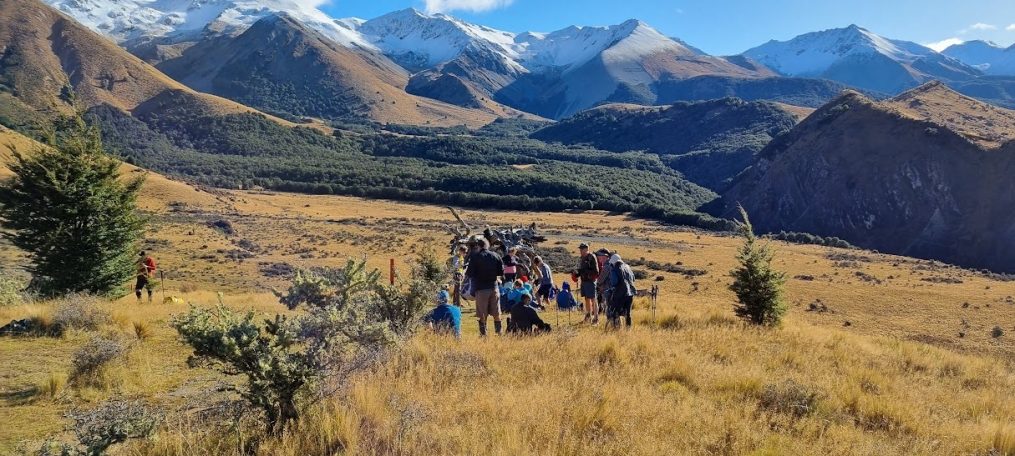|
Leader |
Mentor |
Tail Ender |
| Standards |
Alan |
Jan Br |
Joanne |
| Alternates |
Peter M |
Ali |
Kiwan |
Distance 11.5/7.6km, ascent 519m, time 4hrs.
Other than the usual boots, pack, lunch and water, what else might be required for our Boundary Hill adventure today? Long sleeves and long pants for the prickly matagouri and Spaniard plants – tick. Beanie and gloves in case it’s cold – tick. Sun hat just in case it’s hot – tick. A good jacket for possible rain – tick. A pole for the very rough terrain – tick. And for one of us, a bunch of festive-looking orange ribbons – more on them later.
None of these items looked like they would actually be required as the weather soon deteriorated from a bit dodgy to bad as we travelled away from our second pick-up stop, Yaldhurst. Would this be one of those incredibly rare days when our little bus with 30 hopeful trampers trundling over Porters Pass might have to turn back without having walked a step? The day had already started badly when Some Problem To Do With An Engine had delayed our bus’s departure by 15 minutes. The fresh snow on the mountains was mildly concerning – but those dark rain clouds ahead were even more of a worry.
But of course, it takes more than a few looming clouds and a nip in the air to deter our well-equipped, enthusiastic bunch of trampers, so soon after arriving at our drop-off point on the Lyndon Road the two groups set off towards Boundary Hill.
The swampy parts weren’t as boggy as they could have been and the matagouri didn’t deter us, though it did try. The terrain where the Standards stopped for a (late) morning tea was like a giant rock garden planted out by an unimaginative landscape gardener. Words of wisdom of a botanical nature given to an almost-kiwi tramper: if it’s a little plant, it might be a hebe. If it’s taller, let’s call it a pittosporum. And if its tall like a tree … well, it’s a tree.
The going became tougher and every footstep had to be a considered one. Ali must have momentarily forgotten this as the other 12 Alternates had a ‘Where’s Ali?’ moment when all they could see of her was a glimpse of a wrist and hand before she emerged, unharmed, out of the hole she had fallen into.
Someone who impressed the Alternates with her initiative and abilities was visitor Lynne H, helping others getting across the ‘crevasse’ along the way. We hope we have the pleasure of her company again soon. It was also great to have David back with us again after returning from the States.
Boundary Hill is a different sort of tramp from many others that we do because there is no clear track to follow, and there are no marker poles or signs. Which clump of matagouri should we head to next? Ah, that’s where those pretty orange ribbons came into it – leader Alan was following the faded ribbons kindly tied onto clumps of matagouri by Bishopdale trampers in the past, while frequently tying on plenty of bright new ones for the rest of us to follow. Ever helpful Snipper Brent did some of his magic too with his handy-dandy secateurs.
Lunch for the more energetic half of the Alternates and all the Standards was on top of Boundary Hill. I Googled it, and found Mindat referred to the hill as ‘An elevation standing high above the surrounding area with a small summit area with steep sides.’ It didn’t mention the panoramic toward the peaks of the Main Divide up the Rakaia Valley and out over the Archeron and the Rakaia Gorge area to the south, and that startling blue of Lake Coleridge. Most of our beanies, gloves and even jackets had long since been discarded and it was very pleasant on top of that small summit.
However, before long all the Alternates headed back the way they had come, following those pretty orange ribbons, and the Standards continued on. A surprising highlight on the way down had to be Alan’s discovery of Ron. Ron had a terrible head injury. Ron was dead. Ron was a weasel – well, Ron Weasel sounds a lot better than Ron Stoat so we’ll assume that’s what he was. Regardless, Little Ron’s fur was beautifully soft.
Everyone seemed to be enjoying our Boundary Hill walk, despite the rough terrain. Where else can you traverse an alpine fault (the Porters Pass fault), gingerly edge your way down from the top of a lunar-looking landslip, and see beech trees flourishing on a scree across from a Red Lake? (I didn’t Google how the latter got its name, but my guess is that the names Blue Lake, Green Lake and Emerald Lake had already been taken).
The Standards made good time downhill and had a pleasant, leisurely wait for our bus driver David to arrive with the Alternates already on board before heading back to town.
Text by Shirls

Alts morning tea stop

Stds muster on track

Alts in matagouri

Panoramic views

Alts on track

Down ridgeline

Stds continue descent

































































